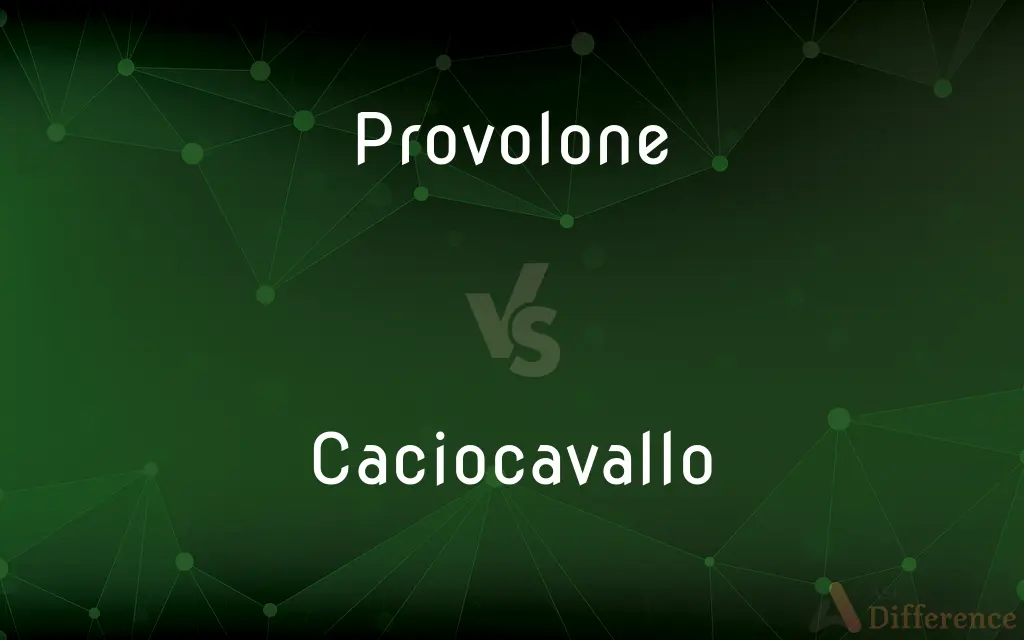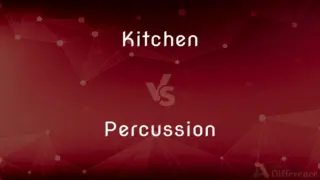Provolone vs. Caciocavallo — What's the Difference?
By Fiza Rafique & Urooj Arif — Updated on April 23, 2024
Provolone is a semi-hard Italian cheese with a smooth texture, often used in sandwiches and pizzas, while Caciocavallo is firmer and aged longer, featuring a more pronounced flavor.

Difference Between Provolone and Caciocavallo
Table of Contents
ADVERTISEMENT
Key Differences
Provolone cheese, originating from Italy, is known for its smooth, creamy texture and mild taste, making it a favorite for sandwiches and pizza toppings. On the other hand, Caciocavallo, also from Italy, tends to have a firmer texture and a bolder, more distinct flavor due to its longer aging process.
Provolone is typically shaped like a pear or a sausage, and it is available in various sizes. Caciocavallo resembles a teardrop and is traditionally hung by a rope to age, which contributes to its unique shape and slightly drier texture.
The aging process for Provolone can vary, but it generally ranges from two months to a year. Meanwhile, Caciocavallo is aged for a minimum of three months and can go up to several years, enhancing its depth of flavor and textural complexity.
Provolone is more commonly used in a variety of cooking applications, from melting over dishes to being eaten fresh. Caciocavallo, while also versatile, is particularly prized for its performance when grilled, as it holds its shape and offers a pleasant chewiness.
Both cheeses are made from cow’s milk, but the specific breeds and the diet of the cows can influence the nuances in flavor and texture between Provolone and Caciocavallo, reflecting their respective regional characteristics.
ADVERTISEMENT
Comparison Chart
Origin
Italy
Italy
Texture
Semi-hard, smooth
Firmer, drier
Shape
Pear or sausage-shaped
Teardrop-shaped
Aging
2 months to 1 year
3 months to several years
Usage
Sandwiches, pizzas, fresh
Grilled, aged, cooking
Compare with Definitions
Provolone
Semi-hard Italian cheese.
Provolone adds a creamy melt to pizza.
Caciocavallo
Italian cheese with a firm texture.
Caciocavallo's firmness makes it excellent for grilling.
Provolone
Versatile in cooking.
Provolone can be used in sandwiches, salads, or baked dishes.
Caciocavallo
Longer aging process.
Caciocavallo is appreciated for its complex flavors developed over time.
Provolone
Pear or sausage shape.
The Provolone's unique shape makes it recognizable on a cheese platter.
Caciocavallo
Ideal for aging.
Caciocavallo can be aged for several years to intensify its flavor.
Provolone
Shorter aging period.
Provolone is aged just long enough to develop its signature taste.
Caciocavallo
Bold, pronounced flavor.
The sharp taste of Caciocavallo enriches hearty dishes.
Provolone
Mild flavor.
Provolone is perfect for those who prefer less pungent cheeses.
Caciocavallo
Teardrop shape.
The distinctive shape of Caciocavallo is due to the traditional aging process.
Provolone
Provolone (pronounced [provoˈloːne], English: ) is an Italian cheese. It is an aged pasta filata (stretched-curd) cheese originating in Casilli near Vesuvius, where it is still produced in pear, sausage, or cone shapes 10 to 15 cm (4 to 6 in) long.
Caciocavallo
Caciocavallo [ˌkatʃokaˈvallo] is a type of stretched-curd cheese made out of sheep's or cow's milk. It is produced throughout Southern Italy, particularly in the Apennine Mountains and in the Gargano peninsula.
Provolone
A semihard, white or pale yellow Italian cheese, made from cow's milk and often smoked.
Caciocavallo
An Italian cheese, similar to provolone, originally from Sicily and the South.
Provolone
A semi-hard cheese made of whole milk from cows. It comes primarily from Southern Italy.
Common Curiosities
How is Caciocavallo different from Provolone in terms of texture?
Caciocavallo has a firmer, drier texture compared to the smoother Provolone.
Which type of milk is used to make Provolone?
Cow’s milk is used for making Provolone.
What makes Caciocavallo unique in its aging process?
Caciocavallo is aged while hanging from a rope, contributing to its unique teardrop shape.
Can Provolone cheese be eaten fresh?
Yes, Provolone can be enjoyed fresh or used in cooking.
What dishes benefit from the flavor of Caciocavallo?
Hearty dishes and grilled foods are enhanced by Caciocavallo’s bold flavor.
Is Provolone available in different varieties?
Yes, Provolone comes in both mild and sharp varieties depending on the aging.
How does the taste of Caciocavallo develop over time?
Its taste becomes more pronounced and complex with aging.
What is Provolone cheese best used for?
Provolone is ideal for melting over sandwiches and pizzas due to its smooth texture.
How long is Provolone typically aged?
Provolone is aged from two months to up to a year.
What is the ideal way to serve Caciocavallo?
Caciocavallo is excellent when grilled or used in aged cheese platters.
Does the shape of Caciocavallo affect its culinary uses?
The shape allows it to be hung and aged uniquely, which can influence its texture and culinary use.
What are the nutritional benefits of Provolone?
Provolone provides calcium and protein.
Can Caciocavallo be used in sandwiches like Provolone?
While it can be used in sandwiches, its firmer texture makes it less common for this use compared to Provolone.
What regions in Italy are known for producing Provolone?
Provolone is mainly produced in the Po Valley region.
What are the best storage practices for Caciocavallo?
It should be stored in a cool, dry place, and can be aged further at home under proper conditions.
Share Your Discovery

Previous Comparison
Kitchen vs. Percussion
Next Comparison
Happy vs. CheerfulAuthor Spotlight
Written by
Fiza RafiqueFiza Rafique is a skilled content writer at AskDifference.com, where she meticulously refines and enhances written pieces. Drawing from her vast editorial expertise, Fiza ensures clarity, accuracy, and precision in every article. Passionate about language, she continually seeks to elevate the quality of content for readers worldwide.
Co-written by
Urooj ArifUrooj is a skilled content writer at Ask Difference, known for her exceptional ability to simplify complex topics into engaging and informative content. With a passion for research and a flair for clear, concise writing, she consistently delivers articles that resonate with our diverse audience.














































